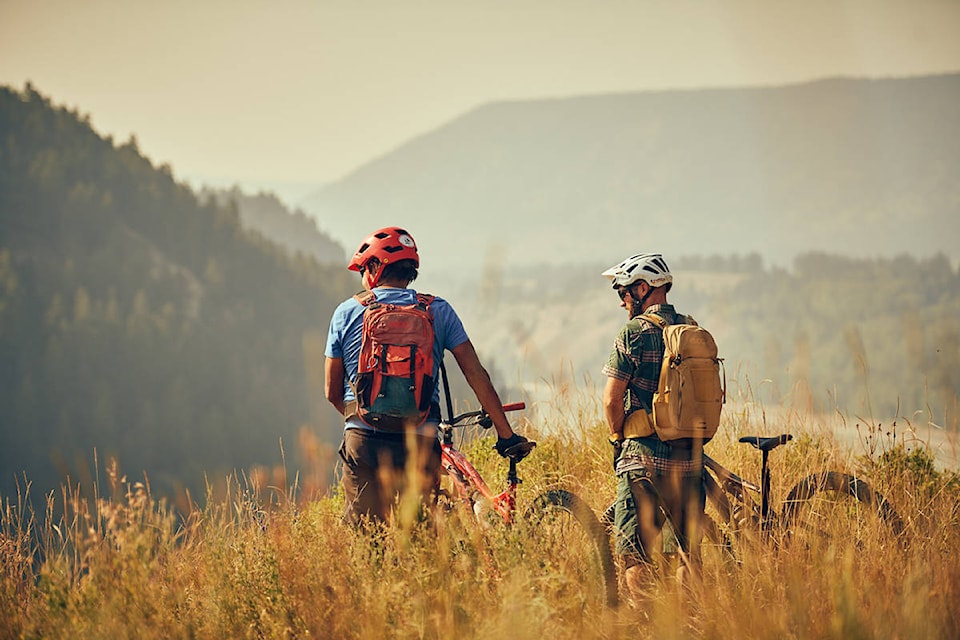The Cariboo Mountain Bike Consortium and the Williams Lake cycling community are always proud to show off the region’s riding opportunities to newcomers, whether from the area or visiting from abroad.
This was exactly the case when writers Daniel Schaeffer and Julia Hofmann, and photographer Paul Masukowitz of BIKE Magazine — a Germany-based publication — were in the Cariboo during the last two weeks of August 2018 following an invitation from First Journey Trails’ and CMBC president Thomas Schoen, and Patrick Lucas with the Aboriginal Youth Mountain Bike Program.
Their story, released last month headlined “New Hunting Grounds,” is a direct reference to some of the group’s time spent riding at the Soda Creek (Xat’sull) Indian Band trails built by Schoen and Indigenous youth from the community.
Schoen, who moved to Canada from Germany in the 90s, has been working with the Indigenous community since then as a tourism and business consultant, a project manager and, more recently, as a trail planner and builder.
The title of the article, he thinks, is an interesting and political one as Germans often refer to “Indian” territory as the “Hunting Grounds.”
“It comes from the famous Karl May books and became a saying,” he said.
“It’s so great to see the recognition for the Aboriginal Youth Mountain Bike Program growing internationally. We worked so hard for many years to expand the programming and outreach. We now work with communities from the Fraser Valley to the Yukon border, from Bella Coola to the Rockies.”
Schoen said the trail building program has had a profound impact, often turning into long-term employment for local trail crews and creates partnerships between bike clubs and First Nations.
The magazine story, itself, written in German, spans over seven pages packed with writing and photography documenting the journalists’ experiences through riding and through interviews with locals.
He added the journalists were completely blown away by their riding experience in the region, and also amazed by the people they met along their journey.
“There is huge interest in North American First Nations culture and history in Germany, and to see an outdoor, recreational-oriented publication pick up this story is fantastic,” Schoen said.
“Travelling with journalists and the photographer made our team aware of how little non-Canadians know about First Nations history in Canada.”
Schoen noted, as president of the CMBC, he was thrilled the story featured our area’s trails and marketed our world-class riding.
“It’s a human interest story, but we here in Williams Lake are proud of our extensive trail network and any chance to promote it. It helps secure funding,” he said.
Read More: German journalists wowed by local mountain biking trails and First Nations communities
During the group’s stay they visited the First Nations communities of Soda Creek, Canim Lake, Simpcw (Barriere) and stopped to ride in 100 Mile House, Kamloops, McLeese Lake and, extensively, in Williams Lake.
The City of Williams Lake, meanwhile, hosted a lunch for the journalists and local mountain bike advocates. Even local professional mountain biker James Doerfling helped out with the youth rides.
Schoen said both Schaeffer and Hofmann are well known German pro riders and travel the world to report on unique and bike-related stories.
Some excerpts and highlights for Schoen from the story are as follows:
• “For community planner Patrick and Thomas, it was a challenge to connect with First Nations until an Elder asked them the question: ‘What do you guys know about mountain biking?’ The rest is history (or, that broke the ice.)”
• “Arriving at a small, remote First Nations village on an ice-cold day, 15 kids eagerly awaiting your arrival … you know you are doing something right.”
• “During dinner prep, Thomas becomes emotional: ‘For these kids, trail building represents a form of digging their way out of a deep hole. Leaving the chains of colonialism behind and claiming back the land that is rightfully theirs.’”
• “An Elder asked Pat: ‘What do you know about mountain biking?’ A question, even in the birthplace of freeriding, no one thought to ask prior. ‘Our kids are into it, they scrape together every bit of dirt, steel fence posts and build ramps and jumps. Maybe you guys can help them build a trail?’ The connection was made and the AYMBP (Aboriginal Youth Mountain Biking Program) was born.”
• “Patrick is rolling into camp. His pickup is filled with shovels, picks, bikes and helmets. Kids come running, freeride pro James Doerfling walks up to help out.
The kids go crazy. Their idol from countless bike movies is here to ride with them. James takes the lead on a trail the crew just finished the day before and the little ones follow him with eagle eyes.”
• “Mothers with tears in their eyes watch: ‘These trails reconnect our kids with the land of their ancestors. They are riding back to their roots.’”
sports@wltribune.com
Like us on Facebook and follow us on Twitter
